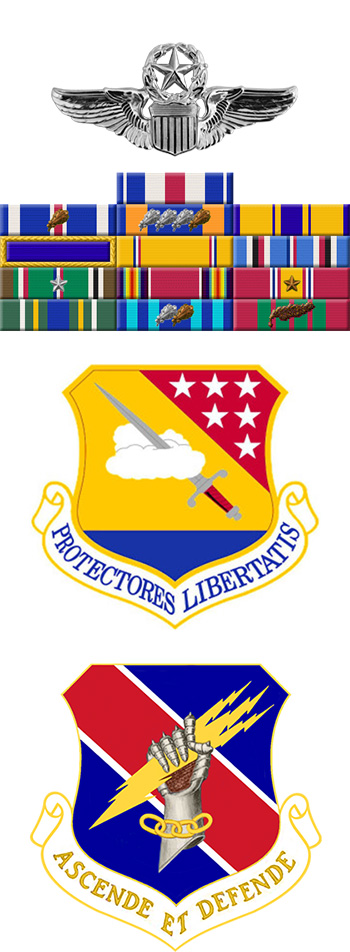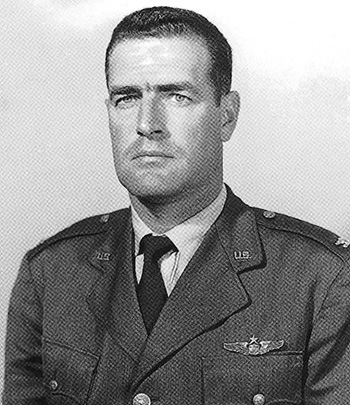
|
Arthur F. Jeffrey |
 |
|||
| Rank, Service | ||||
Colonel O-6, U.S. Air Force |
||||
| Veteran of: | ||||
|
||||
| Tribute: | ||||
Art Jeffrey was born on November 17, 1919, in Brewer, Arkansas. He enlisted in the U.S. Army Air Corps on August 18, 1939, and served as a radio operator until being accepted into the Aviation Cadet Program on September 15, 1941. Jeffrey was commissioned a 2d Lt in the U.S. Army Air Forces and was awarded his pilot wings at Kelly Field, Texas, on April 29, 1942, and then served as a P-38 Lightning pilot with the 50th Pursuit Squadron at Hamilton Field, California, from April to June 1942. His next assignment was as a P-38 pilot with the 83rd Fighter Squadron at Hamilton Field from June to October 1942, followed by service as a P-38 pilot with the 332nd Fighter Squadron at Santa Ana, California, from October 1942 to October 1943. Lt Col Jeffrey next served as a P-38 pilot with the 434th Fighter Squadron of the 479th Fighter Group at Glendale and Lomita, California, from October 1943 to May 1944, and then deployed to England from May 1944 to March 1945. During this time his squadron transitioned to the P-51 Mustang, and Lt Col Jeffrey was credited with the destruction of 4 enemy aircraft in the P-38 and 10 more in the P-51, for a total of 14 enemy aircraft destroyed in aerial combat during World War II, including the first shoot-down of an Me-163 German rocket-propelled fighter. Also during this time, he served as Commander of the 434th Fighter Squadron from November 1944 to March 1945. His next assignment was as Deputy Commander of the 479th Fighter Group in England from March to June 1945, followed by service as Executive Officer and then Base Commander of the 345th Base Unit at Waycross, Georgia, from July 1945 to February 1946. He served as Operations Officer and Flying Safety Officer with the 306th Base Unit at Brooks Field, Texas, from February to October 1946, and then as Commander of the 450th Base Unit at Brooks Field from October to December 1946. His next assignment was as an Air Instructor with the 169th Fighter Squadron of the Illinois Air National Guard at Peoria, Illinois, from December 1946 to August 1950, followed by an Air Force Institute of Technology assignment to complete his bachelor's degree at the University of Pittsburg from August 1950 to June 1951. He served as Comptroller and then Executive Officer of the 123rd Fighter Bomber Wing at Goodman AFB, Kentucky, from June to November 1951, and then with the 123rd at RAF South Ruislip, England, from November 1951 to July 1952. Col Jeffrey next served as Executive Officer and then Commander of the 406th Fighter Bomber Wing at RAF Manston, England, from July 1952 to March 1953, followed by service as Chief of the Training Branch with Headquarters 3rd Air Force at RAF South Ruislip from April 1953 to September 1954. He served as Chief of the Training Branch and then as Chief of the Fighter Branch with the 1002nd Inspector General Group at Norton AFB, California, from September 1954 to August 1957, and then as Chief of the Fighter Division and Chief of the Training Division with Headquarters Tactical Air Command at Langley AFB, Virginia, from August 1957 to June 1958. Col Jeffrey next served as Director of Material with the 836th Air Division at Langley AFB from July 1958 to July 1960, followed by service as Director of Operations with the 314th Air Division at Osan AB, South Korea, from July 1960 to September 1961. He served as Chief of the Fighter Division with the 1003rd Inspector General Group at Norton AFB from September 1961 to January 1963, and then as Deputy Chief of the Flight Safety Division with the 1002nd Inspector General Group at Norton from January 1963 to September 1965. His next assignment was as Director of Material with the 834th Air Division at England AFB, Louisiana, from September 1965 to September 1966, followed by service as Director of Material with the 839th Air Division at Sewart AFB, Tennessee, from October 1966 until his retirement from the Air Force on October 1, 1968. |
||||
|
||||

